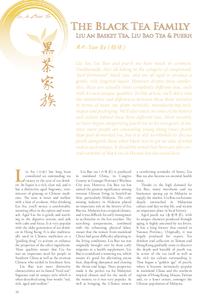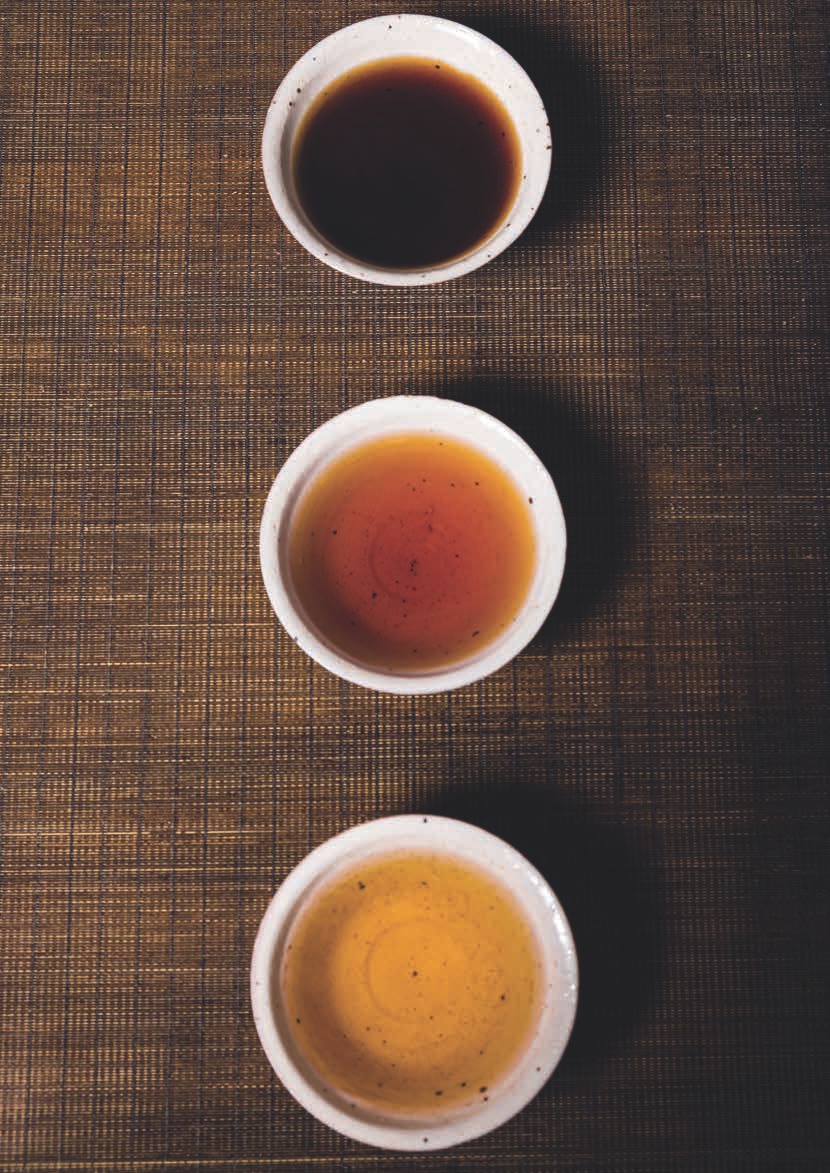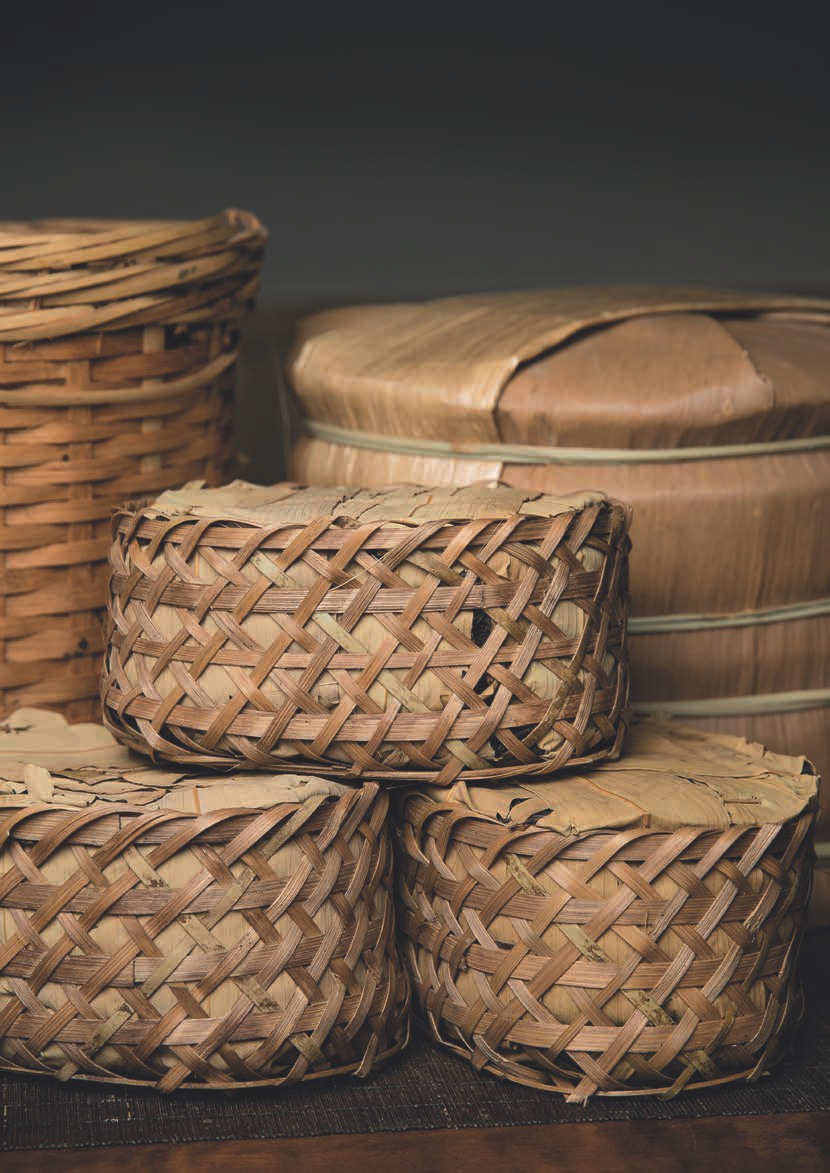
 |
|
Liu An (六安) has long been considered an outstanding tea variety in the eyes of tea drinkers. Its liquor is a rich, clear red, and it has a distinctive aged fragrance, reminiscent of ginseng or Chinese medicine. The taste is sweet and mellow with a hint of coolness. After drinking Liu An, you'll notice a comfortable, warming effect in the spleen and stomach. Aged Liu An is gentle and soothing to the digestive system, and aids with calm and focus. It is very popular with the older generation of tea drinkers in Hong Kong. It is also traditionally used in Chinese medicines as a "guiding drug" to activate or enhance the properties of the other ingredients. These qualities meant that Liu An met an important need for people in Southern China as well as the overseas Chinese who settled in Southeast Asia.
Liu Bao tea's most distinctive characteristics are its famed "betel nut" fragrance and its unique style which is often described using four words: "red, rich, aged and mellow."
Liu Bao tea (六堡茶) is produced in mainland China, in Cangwu County in Guangxi Province's Wuzhou City area. However, Liu Bao tea has earned the greatest significance among overseas Chinese living in South-East Asia, particulary Malaysia. The early mining industry in Malaysia played an important role in the history of Liu Bao tea. Malaysia has a tropical climate, and it was difficult for early immigrants to acclimatize to the hot weather. The scorching temperatures, combined with the exhausting physical labor, meant that the miners from mainland China had great difficulty adjusting to the living conditions. Liu Bao tea was originally brought over by these early migrants as a health supplement. Liu Bao is considered a warming tea, which means it's good for alleviating excess heat, dispelling dampness and clearing the throat and lungs. These properties made it the perfect tea for Malaysia's tropical climate and for the needs of the miners, so it was very popular. As well as bringing the Chinese miners a comforting reminder of home, Liu Bao tea also became an essential health tonic.
Thanks to the high demand for Liu Bao, many merchants and tea businesses sprang up in Malaysia to supply the market. Liu Bao tea became deeply entrenched in Malaysian culture and day-to-day life, and retains an important place in local history.
Aged puerh tea (老普洱茶), with its unique character produced through aging, is highly esteemed by tea lovers. It has a long history that started in Yunnan Province. Originally, it was largely produced for export. Tea drinkers and collectors in Taiwan and Hong Kong gradually came to discover the depth and breadth of puerh tea, in terms of the tea itself as well as the rich tea culture surrounding it. Thus began a "golden age" of puerh, where it become immensely popular in mainland China and the southern regions of Hong Kong, Macau, Taiwan and, to a lesser extent, amongst the Chinese population of Malaysia.


Puerh tea (普洱茶) is traditionally compressed into cakes or bing (餅) and can be classified according to age, with several traditional classifications, including "antique" cakes (from the mid-1950s or thereabouts), "stamped" tea cakes (from the 1950s to the 1960s) and "seven sons" tea cakes (from 1966 to 1979), among others. Because of its capacity for aging and its rich history and culture, old puerh is still very valuable, and even new puerh is no less valued - it really is a very popular tea.
Qimen County in Anhui is famed for its tea. Liu An is made from the Zhuye (楮葉) tea plant varietal, which is native to Qimen. The Zhuye tea plant is a hardy, bush-like varietal with a semi-open branch shape, and propagates via sexual reproduction. This varietal produces a steady harvest of high-quality leaves, and is mainly found throughout parts of Anhui Province, including Tafang, Pingli, Rongkou, Luxi and Likou. Although technically there is no specification as to which leaf variety An tea should be made from, it's generally acknowledged that Zhuye leaves produce the best Liu An. Zhuye plants are currently one of the most preferred tea varietals in mainland China, and have also been introduced to other places, such as India, Japan, Vietnam, Pakistan and the former Soviet Union - so it really is a world-famous tea plant varietal.
The tea plant varietal used to make Liu Bao originates in Liu Bao Village in Cangwu County, Guangxi Province. The varietal is usually simply referred to as "Liu Bao tea," or "the original Liu Bao varietal," to differentiate it from the other varietals of tea plant that grow in the area. These include the large-leaf and medium-leaf varietals that were brought over from other provinces, such as Yunnan and Hunan, in the 1970s and 1980s, as well as the Camellia sinensis cultivar, "Guilu 1," that has been planted in the area in the last few years. Because this varietal has both male and female trees which crosspollinate, the trees have undergone a long process of natural selection, and so are quite hardy and adaptable. There's quite a lot of individual variance between trees of this varietal in, for example, the color of the buds: there are green bud, yellow-green bud, red bud and purple bud types. They all tend to bud early, and can also be divided into early-budding and slightly later-budding varietals. In terms of leaf shapes, there are a few types, including long leaf, oval leaf, regular leaf and "bamboo shoot."
According to China's 2002 International Puerh Tea Research Symposium, this is the official word on the original home of puerh: "Puerh is a famous historic tea variety, with a distinctive character owing to its terroir and manufacturing process: it is made from the leaves of the dianqing (滇青) tea plant, a largeleaf varietal from Yunnan Province." This large-leaf puerh varietal grows mainly in the regions of Simao and Xishuangbanna, around the Lancang River valley in Yunnan. It reproduces sexually and is upright and tree-shaped.
Puerh tea is sometimes put into the black tea category, but it should actually have a category all its own. Traditionally, all puerh was fermented before consumption, whether artificially, in the case of shou, or naturally over time, in the case of sheng. Tea lovers back in the day considered new, sheng puerh as "unfinished" and rarely drank it, except to see how it was aging. Therefore, all puerh tea was fermented and fit nicely into the black tea genre, which is categorized by post-production fermentation.
Over the years, we have talked extensively about our unique categorization of tea, which is important because it helps you explore and understand tea better. Traditionally, there were six genres of tea: white, yellow, green, black, red and oolong. Categories are always arbitrary, ultimately, and only useful for communication and education. And when our understanding of the world changes, the world itself changes, or perhaps both, then our categories also need to shift. And that is what has happened in the tea world - change. Puerh used to reside comfortably in the black tea category, but that was back when all the puerh consumed was either naturally fermented (aged) sheng or artificially fermented shou tea. All the tea was dark, in other words. Due to the unique terroir of Yunnan, the very special trees used to produce puerh, its unique history, processing, aging and appreciation, we have found that students of tea understand the genres of tea much more quickly and clearly when we separate puerh as a seventh genre. And the fact that students of tea understand tea better and more expediently is all the argument we need for presenting the genres in this way!
One solution to this change in tea production/consumption would be to put young, sheng puerh in the green tea category, and aged sheng along with shou in the black tea category, but that seems much more confusing than just giving puerh tea its own genre. We think that since it's the oldest tea, and from the birthplace of all tea, puerh deserves its own genre!
An tea is classified as a "postfermented," compressed black tea. The manufacturing process is divided into two phases: initial processing and refining. The process is delicate and complex, and takes more than half a year from start to finish. The tea is usually picked with three leaves to one bud. Initial processing involves four steps: spreading the leaves, kill-green, rolling and drying. After this initial processing phase, the dry tea leaves are black and glossy, and when brewed the flavor and leftover leaves are quite similar to semi-processed puerh maocha. It's not until after the refining process that Liu An tea takes on its own unique character. The refining process has ten steps to it: sifting, winnowing, picking out debris, blending, high-heat firing, "night dew," steaming, compressing into baskets, baking over a frame and packaging. Of these steps, a few stand out as unique: the tea leaves are fired over a high heat then left out overnight to absorb the dew before being baked slowly over a bamboo frame until dry.
The high-heat firing step is also known as "full firing," and is a real test of the tea master's experience - the temperature must be controlled very precisely. The "night dew" step happens around Bailu, the "White Dew" solar term in mid- to late September. After firing, the leaves are spread out to a depth of around ten centimeters and left out to absorb the moisture from the dew; they are generally turned over once during the night. Later, once the tea has been compressed into bamboo baskets, the baskets are tied together in rows then placed on a wooden frame, over hot coals, in a special drying room, with a cotton quilt laid over the top to evenly regulate the heat.
According to the standard definition, Liu Bao tea is made using the new buds, leaves and stems of the tea plant. The traditional manufacturing process also involves two phases. Initial processing begins with the kill-green step, followed by first rolling, "heaping," second rolling and drying. The refining process includes sifting, winnowing, picking out debris, blending, initial steaming and heaping, second steaming, to compress the tea, and aging. The heaping step is part of the oxidation process and is essential to the character of this unique black tea.
As with the other two kinds of tea, the puerh manufacturing process can be divided into two main stages (often at farm and factory separately). Initial processing includes pan-firing to halt oxidation (known as "killgreen"), hand-rolling and sun-drying. The refining phase involves sifting out the tea dust, picking out the stems, winnowing to remove yellow leaves, and then grading the leaves by thickness and length. The resulting tea can then be sold as loose leaf, or steamed and compressed into various shapes, and then is exported to places such as Tibet, Hong Kong, Vietnam and Myanmar.
After the kill-green and rolling steps, the tea is sun-dried, and the resulting product is puerh maocha, often referred to as "raw" or "unprocessed" tea leaves (though they're really semi-processed). In modern times, depending on how the maocha is processed, it can be made into sheng puerh or shou puerh. To make shou ("ripe") puerh, the maocha is "heaped" into moist piles to oxidize before being compressed. For sheng ("raw") puerh, the oxidization step is skipped, and the tea is compressed into the finished product straight away, before being allowed to mature through aging.
The traditional packaging of Liu An can be broken down into three components: the inner basket, the middle layer, and the outer layer. The inner layer is a squat, oval-shaped basket woven from bamboo strips. Bamboo is an excellent material, as it's not only economical and readily available, but also flexible and resilient. When packing the tea, the baskets are lined with bamboo leaves, which protects the tea and enhances its fragrance and cooling properties.
Old Liu An is usually packed with around 500 grams per basket. The baskets are then put into pairs, then three pairs are strung together into a row, then ten rows are strung together into a block. So, one block of tea contains fifty individual baskets, or around thirty kilograms of tea. These days, however, new Liu An is often packed in 250-gram baskets for ease of shipping. The smaller baskets are put into pairs, with four pairs to one row, and seven rows in a block, so you end up with fifty-six baskets at a total weight of around fourteen kilograms.
Although Liu Bao tea can be sold in many forms - loose leaf or compressed into bricks or cakes - the most traditional method is to steam it and then compress it into baskets. Although the baskets used are similar in appearance to Liu An baskets, they tend to be much bigger - baskets of old Liu Bao can hold as much as forty or fifty kilograms of tea. But because their large size made them difficult to transport, Liu Bao later began to be sold in one-kilogram baskets, as well as tea cakes, boxes, or loose-leaf in paper bags. However, if you want to accurately determine the vintage of an old Liu Bao tea, the only reliable way to tell is still to look at the markings and characters printed on the original old basket and the burlap sack that it was wrapped in.
Puerh tea comes in many shapes and forms. It can be compressed into rectangular tea bricks (磚茶, zhuan cha), bowl shapes (沱茶, tuo cha), or round flat cakes (餅茶, bing cha). These are largely made with sheng puerh maocha, which is then steamed to soften it and shaped using various molds or cloth balls. Shaping the tea has become a unique part of puerh tea culture. One particulary well-known variety is "seven sons" tea cakes, or qi zi bing (七子餅). These cakes got their name from the way tea merchants used to wrap them in tall stacks of seven cakes for ease of transport. Each cake weighed around 375 grams, and the tea stacks were packed together in groups of twelve, so altogether they weighed about thirty kilograms. Once they were all packed up, the tea cakes were transported along the old tea horse road, and sold to tea drinkers in all sorts of places.

